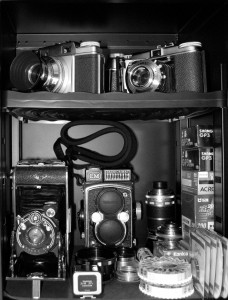Caring for your Camera

A dry cabinet is where you should be storing your equipment. Photo: James/Creative Commons
Storage
For general safe keeping, we strongly recommend that cameras and lenses be stored in a clean and dry area such as a dry cabinet. In humid Singapore, the dry cabinet is essential to keep fungus from growing in your equipment.
As they are available in a wide array of shapes and sizes, choose one that would store your camera, lenses and accessories like flashes and cables comfortably. For up to two camera bodies and three lenses, the smallest-sized 38L AIPO AP-38EX would fit the bill just right.
Limiting the size of the dry cabinet would probably help you refrain from buying excessive equipment to fill up the voids!
Camera Care
The best way to keep dust out of your camera sensor is to minimise the exposure of the sensor to the environment. This means that people who own only one lens would probably never, ever find a single spot of dust on his or her sensor. But for most of us who own more than one lens, we’re bound to find dust spots on our sensors every now and then depending on how frequently we change lens and the environment in which we change the lenses in. If you’re storing your DSLR with no lens mounted, remember to cap the body up to keep your sensor, mirror and focusing screen clean of dust.
Newer cameras such as the Canon EOS 40D, Nikon D60 and Sony A200, to name a few, come equipped with self-cleaning mechanism that would keep your sensor free of dust. If you do find dust on the sensor that the camera cannot clean by itself, we recommend sending it in to your manufacturer to get it cleaned for a nominal price of about $20. Canon users can find a list of prices for various repair and maintenance services listed on their website.
Quite honestly, we do not clean the camera sensor ourselves, and we would encourage you to leave its delicate handling to the experts. If however you are still interested to clean the sensor yourself, you can read more about the different methods and their pros and cons.
Lens Care
Lenses are best cleaned using a blower for loose dust particles and anti-static cloth for fingerprints etc. We generally hold the lens facing downwards and use a blower to blow off loose dust particles.
You should use an anti-static cloth to wipe off the dirt/fingerprint only when the loose dust particles have been blown off lest you scratch your lenses. Try not to use cotton or clothing to clean the lens as the fibres may get stuck or worse, scratch the glass elements. Anti-static cloths are available at most camera stores and optical shops or come packaged with cleaning kits bundled with blowers.
Dust will inevitably appear within your lenses after using them for some time. You should just leave them alone since they do not degrade your image quality and there’s no easy way to clean them aside from tearing your lens apart.
Filters

UV filters worsen lens flare. Photo: alforque/Creative Commons
Screwing on a cheap UV filter on an expensive lens ultimately defeats the purpose of spending the extra money for superior optics. Developing the habit of religiously keeping your lens capped when not in use would be a better (and more cost effective) practice to prevent accidental damage.
However not everyone is comfortable leaving an expensive lens completely unprotected. So if you do get an UV filter, get one with multi-coating to reduce flare, and don’t be afraid to remove the filter if it’s giving you trouble during a shoot. Filters come in different sizes to fit different lenses, so find out what thread size your lens uses (see the back of your lens cap, eg. 58mm, 72mm) before buying one.
Storage Media and Accessories
Storage media like CF/SD cards are hardier than your portable hard disks, but it would be a good idea to keep them away from magnetic materials to prevent corruption or loss of data. In fact keeping cameras away from magnets would be a wise practice too. Remove batteries from cameras, flashes and other devices if they’re not going to be used for some time to prevent them from leaking and spoiling your equipment. Formatting your storage media onboard the camera is better than doing it on your computer. Formatting a storage card involves deleting all the recorded (and protected) data and optimising it for usage on the camera hence it is best done on the camera itself.
Having all the equipment stored in a dry cabinet is great but thats not what cameras were made for, so do inspect them and use them regularly to keep them clicking like they should instead of leaving them idle in storage. If you are not likely to be using the camera for a long period of time (say a year) it might be good to just take it out once a month and shoot a few frames to keep the shutter mechanism working. Like a rolling stone gathers no moss, a well used camera is less likely to give problems than one that has been dormant for years.

Comments are closed on this post.